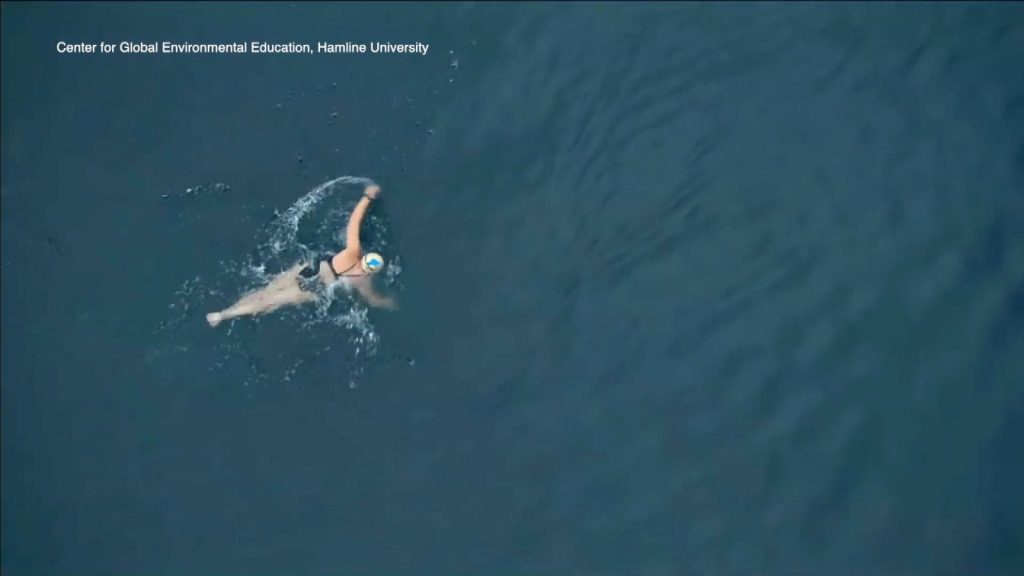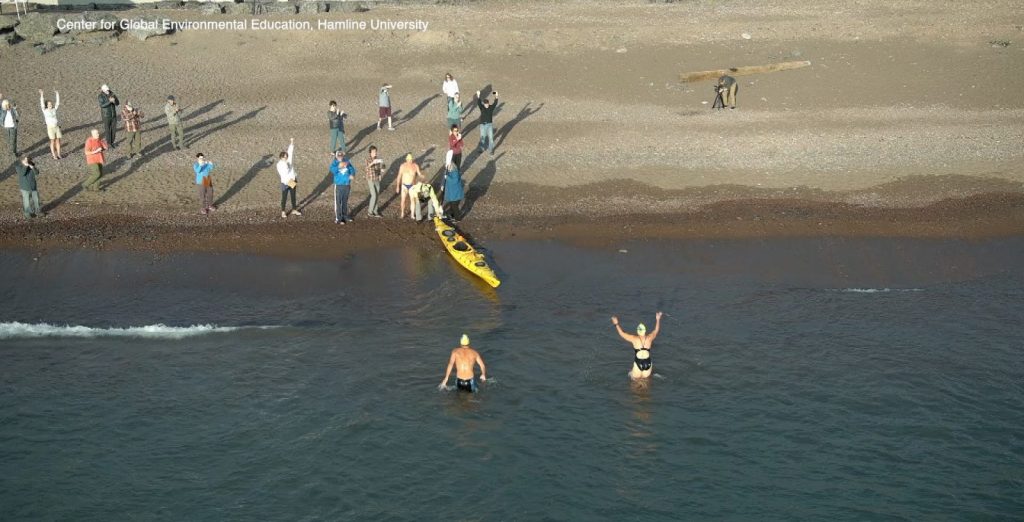Plymouth Swimmer Takes Part in 45-Mile Lake Superior Relay
A Plymouth swimmer with five other athletes set out to swim a more than 40-mile open water relay in Lake Superior. They achieved that goal with another goal in mind: raising awareness of climate change.
As a lifelong Minnesota swimmer, Plymouth’s Karen Zemlin knows what it means to go with the flow.
“We have all these opportunities in Minnesota, and all these lakes we have just around the corner,” Zemlin said.
She was introduced to open-water swimming by her father and said she fell in love with the challenge. The sport, she said, is about adapting to ever-changing, almost unpredictable conditions.
Open-Water Challenges
Zemlin found community in the activity.
“We are this subgroup of swimmers that just want to challenge ourselves in bigger ways,” Zemlin said.
Years ago, she attempted to swim the English Channel. She was pulled out of the water due to hypothermia after 12 hours of swimming.
Zemlin decided to take her training to Lake Superior, the largest and chilliest Great Lake. She said she spent five weeks training around its shores and became very familiar with its landscape.
“The amount of beaches are great,” Zemlin said.
The training paid off and she took her skills back to the English Channel, completing the challenge.
In late August, she and five other like-minded distance swimmers headed back to Lake Superior again. This time their goal was to set a new relay course. Specifically, the first nonstop relay from Split Rock Lighthouse to Duluth’s Canal Park.

Karen Zemlin takes off for an hour of swimming in Lake Superior.
Zemlin, along with Seth Baetzold, Michael Miller, Jeff Everett, Craig Collins, William McGrath and alternate David Cameron took on the challenge. All but one of the team members are Minnesotans.
“Each (race) is so different from the last. This one gave me this whole perspective because it was done in a relay form,” Zemlin said. “When those conditions change, we are changing very much how we are responding to those conditions.”
More Than a Swim
The unprecedented swim is also a mission.
“Lake Superior is among the fastest warming of the world’s large lakes,” said John Shepard, the assistant director of the Center for Global Environmental Education at Hamline University.
He said the lake is reaching unusual 70-degree Fahrenheit temperatures. Between 1975 and 2006, the summer surface temperature increased by 4.5 degrees.
That warming, he said, is caused by the lack of ice cover in the winter time. Typically, ice cover protects the lake from warming. As the climate heats up, the amount of ice on Lake Superior reduces.
He said that warmup is causing mixed results. It’s easier for swimmers and more viable recreationally, he said.
“This marathon relay swim that just wrapped up yesterday would have been more difficult in years’ past,” Shepard said.
But at the same time, he said, the warmup has a big impact on the region’s climate.
Shepard said there are three major concerns to point to.
- The region saw one 500-year storm, and two 1,000-year storms over the span of six years. Shepard said the warmer body of water is leading to more frequent, severe storms.
- More algae blooms are developing in the lake, with some species that produce harmful toxins in the lake. Shepard said the algae blooms are appearing in places that are unprecedented in Lake Superior.
- A warmer lake makes it easier for invasive species to survive. Shepard said those species are a threat to the lake’s natural system.
“A Sea Change for Lake Superior”
The Center for Global Environmental Education is creating a documentary for public television on Lake Superior’s warming.
The documentary is using the relay swim to help tell the Great Lake’s story. Shepard also hopes to raise awareness of the changing climate close to home. He said its set to release in late November or early December.
“We all have a role to play in reducing some of the impacts that are going to be happening; that are happening as the climate warms,” Shepard said.
This week, the swimmers’ role was crossing the Duluth shoreline.
And 45.6 miles later, Zemlin’s team achieved that goal.

Two of the teammates from the Lake Superior relay team cross the finish line after 45.6 miles.
“When we stand on the beach at the end, that’s the balance of ‘Look what we got to do and how amazing that was,'” said Zemlin. “And knowing how far those 70-degree water temperatures are reaching in Lake Superior… that’s an indicator of what’s going on.”


